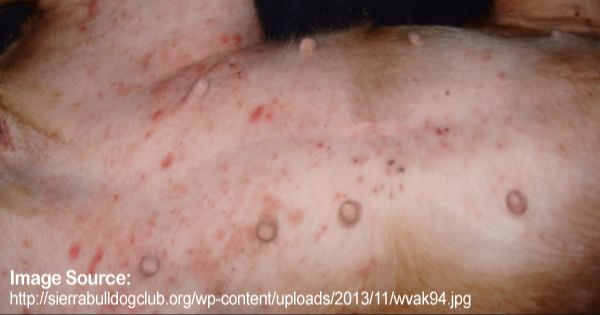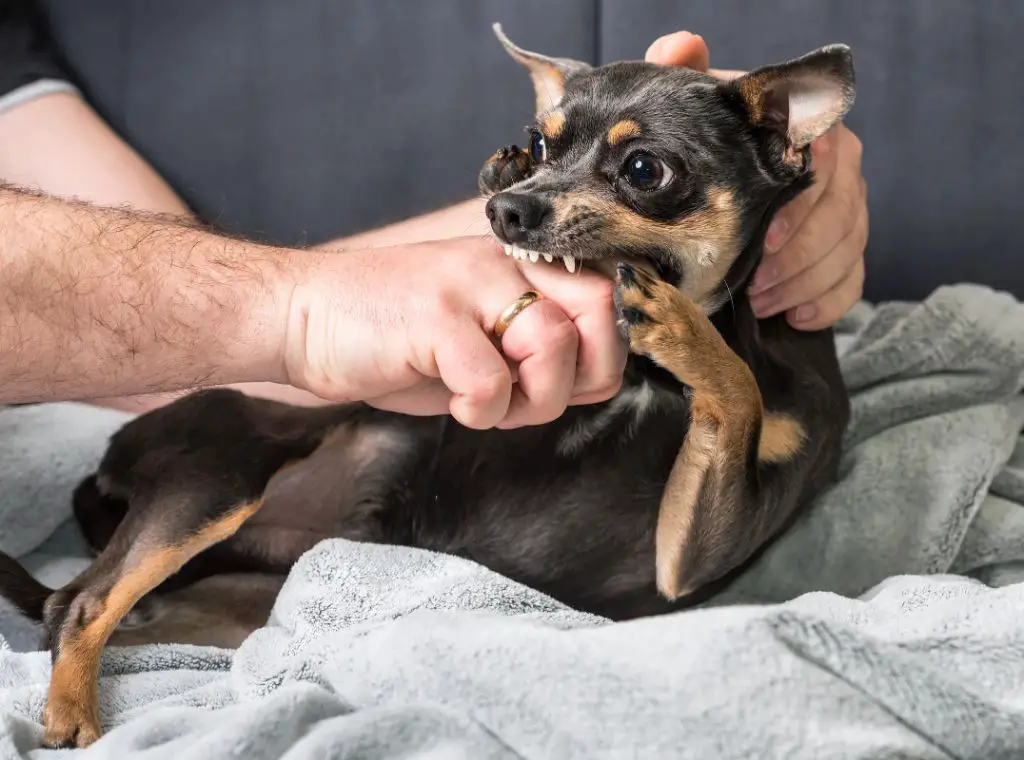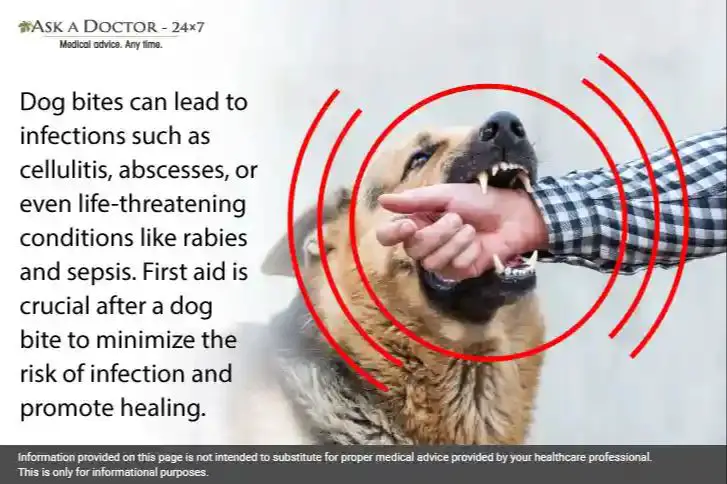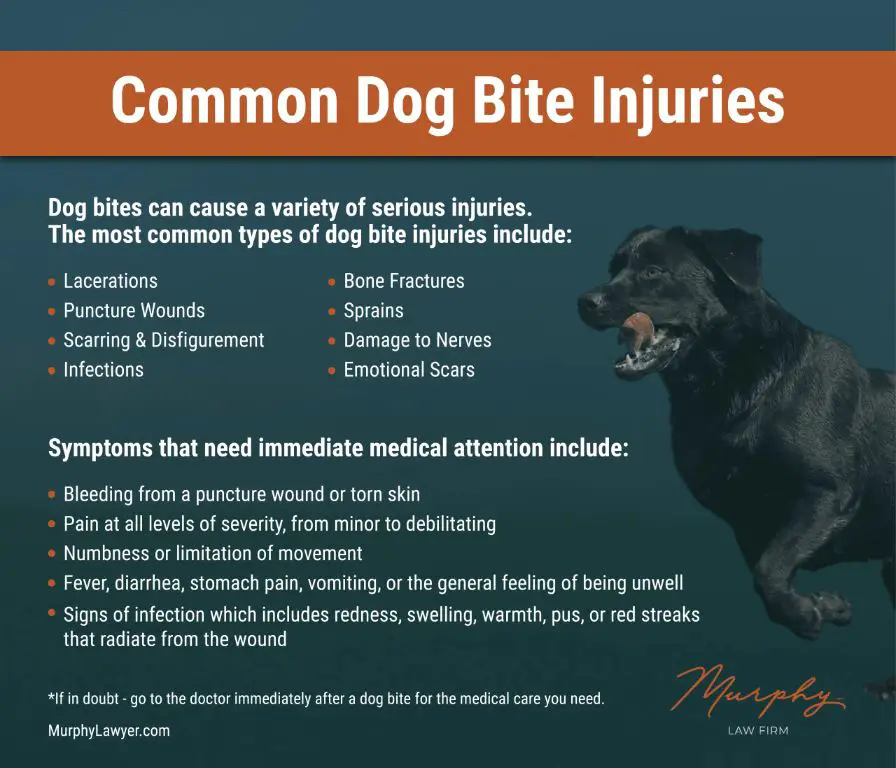Introduction
Dog bites can cause bacterial infections due to the bacteria present in a dog’s mouth. While most dog bites are minor and do not result in infection, they should still be properly cleaned and monitored. It’s important to seek medical care after a dog bite to assess the wound, get a tetanus shot if needed, and get antibiotics if an infection develops. The purpose of this article is to explain what to do after a dog bite, including signs of infection to watch for, when to seek medical care, how to clean the wound, whether antibiotics or a tetanus shot are needed, and tips for preventing infection.
Signs of Infection
There are several common signs that a dog bite has become infected, which typically occur within 24-48 hours after the bite. These include:
- Redness, swelling, and tenderness around the wound – This is caused by inflammation and increased blood flow to the area as your body fights the infection.
- Pus or discharge draining from the wound – Pus is made up of fluid, dead cells, and bacteria, and signifies infection.
- Fever – An oral temperature over 100.4°F often accompanies skin infections as the immune system responds.
- Blisters or oozing around the bite – Fluid-filled blisters and oozing signal that bacteria has invaded tissue.
- Pain at the bite site – The area often becomes increasingly painful as infection progresses.
According to the CDC, blisters around the wound can appear within hours of the bite as a sign of infection. Drainage, redness, swelling, and fever at the bite also point to spreading infection under the skin or into the blood. Watch for these and other symptoms after a dog bite and seek medical attention at the first signs of infection.

Seeking Medical Care
It is advisable to see a doctor if you get bitten by a dog, especially if the bite breaks the skin. Dog bites can introduce bacteria deep into the wound, leading to possible infection. According to experts, it’s crucial to seek medical care within 24 hours after a dog bite that breaks the skin (https://www.afcurgentcare.com/athens-tn/blog/should-i-seek-medical-care-for-a-dog-bite/).
Infection is a serious risk with dog bites. The dog’s mouth contains many types of bacteria that can enter the wound. Some potential infections include cellulitis, abscesses, joint infections, and blood infections. Seeking prompt medical attention can help thoroughly clean the wound and assess the need for antibiotics or a tetanus shot.
If the bite is deep, you are unable to completely clean it, or there are signs of infection such as increased pain, swelling, redness, warmth, red streaks, drainage, or fever, it’s crucial to be evaluated by a doctor right away (https://www.goodrx.com/conditions/wound-care/when-do-i-need-medical-attention-for-a-dog-bite). The longer you wait, the higher the risk of complications.
Cleaning the Wound
Immediately after being bitten, the first step is to clean the wound thoroughly. The CDC recommends washing the bite with mild soap and warm running water for at least 5 minutes to remove dirt, debris, and bacteria (source). Gently clean around the wound, but do not scrub or soak it.
Do not use hydrogen peroxide or alcohol to clean the bite. Hydrogen peroxide can damage tissue and slow healing, while alcohol can cause pain and irritation (source). After washing, you can apply a thin layer of antibacterial ointment to help prevent infection.
Proper wound cleaning right away is crucial, as it removes bacteria on the skin that can enter through punctures or lacerations from the bite. Thoroughly flushing bite wounds with soap and water is the best immediate first aid.
Getting a Tetanus Shot
If you have not had a tetanus booster in the last 5-10 years, it is recommended to get one after a dog bite as a precaution against tetanus infection. Tetanus is caused by a bacterium called Clostridium tetani which can enter the body through wounds. The tetanus bacteria thrive in environments with low oxygen, such as in a deep puncture wound. Dog bites often cause puncture wounds and crush injuries that damage tissue and can create low oxygen conditions perfect for C. tetani to multiply.

Tetanus vaccination provides antibodies that fight the toxins released by the tetanus bacteria to prevent severe illness. Immunity from the vaccine wanes over time so it’s important to get a booster shot every 10 years. If you haven’t had a tetanus shot in over 5 years, it’s safer to get one after a dog bite rather than risk tetanus infection, which has a high mortality rate if treatment is delayed. The CDC recommends a tetanus booster if it has been more than 5 years since the last dose or if you have a dirty wound and are unsure of your vaccination status.
According to the American College of Emergency Physicians, “A tetanus shot may be required if you have not had one within 10 years or if you are unsure of when you last had one. Tetanus is a bacterial infection that can enter the body through any break in the skin” (Source). Getting a tetanus booster soon after a dog bite can prevent the potentially fatal consequences of tetanus infection.
Taking Antibiotics
Antibiotics are often prescribed after a dog bite to prevent infection, since a dog’s mouth contains bacteria that can cause infection in the wound. According to the American Academy of Family Physicians, amoxicillin-clavulanate is generally considered the first-line oral antibiotic for dog bites. The clavulanate helps cover some of the bacteria commonly found in dogs’ mouths that are resistant to amoxicillin alone (https://www.aafp.org/pubs/afp/issues/2001/0415/p1567.html).
For higher risk or more severe bites, the initial dose of antibiotics may need to be administered intravenously. A commonly used IV combination is clindamycin and a fluoroquinolone for adults or clindamycin and trimethoprim-sulfamethoxazole in children, according to Medscape (https://emedicine.medscape.com/article/768875-medication).
The doctor will assess factors like the location of the bite, depth of wound, amount of tissue damage, and health of the patient to determine if antibiotics are needed and which ones to prescribe. Antibiotics help prevent infection from spreading from the initial bacteria introduced by the dog’s mouth.
Using Antiseptics
Keeping the wound clean is crucial for preventing infection after a dog bite. Over-the-counter antiseptic solutions can help clean and disinfect the wound. Some commonly used options include:
Hydrogen peroxide – Diluted 3% hydrogen peroxide can help clean debris from the wound and kill bacteria. Be sure to rinse thoroughly after use.1
Povidone-iodine – Also known as Betadine, this antiseptic solution contains iodine and is effective at killing microbes. It can sting when applied.2
Alcohol – Rubbing alcohol can disinfect wounds, but should be diluted first to avoid irritation. It can help cleanse dirt and debris from the bite.1
Soap and water – Thoroughly washing the bite with mild soap and water helps remove bacteria and foreign particles. Be sure to rinse well after cleaning.2
Using an antiseptic solution 2-3 times a day, along with keeping the wound covered, can help prevent infection and promote healing after a dog bite.
Watching for Rabies
Rabies is a serious viral disease that affects the central nervous system. It is spread through the saliva of infected animals and is usually transmitted through a bite. According to the WHO, [https://www.who.int/news-room/fact-sheets/detail/rabies] rabies causes tens of thousands of deaths worldwide every year. If untreated, rabies is almost always fatal.

If you are bitten by an animal that could potentially have rabies, rabies shots may be recommended. This is especially true if the animal appeared sick or was acting aggressively. According to the CDC, [https://www.cdc.gov/rabies/exposure/animals/domestic.html] dogs, cats, and ferrets should be observed for 10 days after a bite to check for signs of rabies. Wild animals or stray dogs/cats would warrant immediate rabies treatment.
The first symptoms of rabies may be nonspecific, including fever, headache, and general weakness. As the disease progresses, more specific symptoms arise including insomnia, anxiety, confusion, slight or partial paralysis, excitation, hallucinations, agitation, hypersalivation, difficulty swallowing, and hydrophobia (fear of water).
Death usually occurs within days of more serious symptoms starting. There is no cure once clinical signs of rabies appear. However, the rabies vaccine is highly effective in preventing the disease if given promptly after an exposure.
Preventing Infection
There are several steps you can take to help prevent infection after a dog bite:
- Keep the wound covered with a clean bandage or dressing. Change the bandage daily or whenever it becomes dirty or wet. According to the CDC, keeping the wound covered helps prevent bacteria from entering (1).
- Wash hands thoroughly before and after touching the wound or changing bandages. This prevents spreading additional bacteria to the area (2).
- Avoid scratching or touching the wound. Scratching can further damage the tissue and introduce more bacteria (3).
- Watch for signs of infection like redness, swelling, increased pain, pus, warmth around the wound, red streaks, fever, etc. Seek medical care if any of these occur (4).
- Finish any course of antibiotics prescribed by your doctor. Stopping antibiotics early can allow surviving bacteria to become resistant (5).
- Use an antiseptic like povidone-iodine to help kill microorganisms and promote healing. Apply around (not directly into) the wound (6).
Following wound care instructions from your doctor can lower the risk of complications and serious infection after a dog bite.
When to Seek Care
In most cases, a dog bite can be treated at home with first aid and close monitoring. However, you should seek immediate medical care if you experience any of the following:

- Excessive bleeding that cannot be stopped with direct pressure
- Signs of infection like increasing pain, swelling, redness, heat, red streaks leading from the wound, discharge of pus, or foul odor
- Fever above 100.4°F (38°C)
- Flu-like symptoms such as chills, body aches, headache, weakness, or fatigue
- Inability to use the injured body part
- The bite is on the face, hand, foot, or genitals
- The bite penetrated deep into the tissue or damaged tendons, ligaments, blood vessels, nerves, or bones
- You were bitten by an animal that could be rabid like a raccoon, skunk, fox, or stray dog or cat
Bite wounds can progress rapidly to become infected so it’s important to monitor symptoms closely and seek medical care at the first signs of a serious issue. Severe infections may require intravenous antibiotics, surgical debridement, or reconstruction. The sooner treatment begins, the better the outcome.
